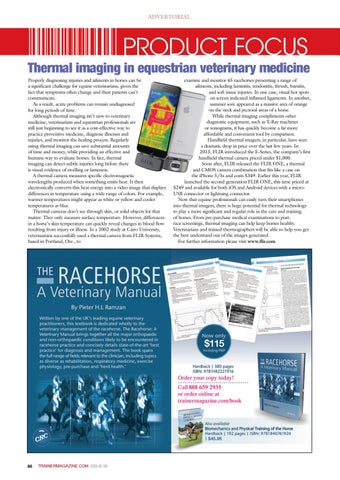ADVERTORIAL
Thermal imaging in equestrian veterinary medicine Properly diagnosing injuries and ailments in horses can be a significant challenge for equine veterinarians, given the fact that symptoms often change and their patients can’t communicate. As a result, acute problems can remain undiagnosed for long periods of time. Although thermal imaging isn’t new to veterinary medicine, veterinarians and equestrian professionals are still just beginning to see it as a cost-effective way to practice preventive medicine, diagnose illnesses and injuries, and monitor the healing process. Regularly using thermal imaging can save substantial amounts of time and money, while providing an effective and humane way to evaluate horses. In fact, thermal imaging can detect subtle injuries long before there is visual evidence of swelling or lameness. A thermal camera measures specific electromagnetic wavelengths produced when something emits heat. It then electronically converts this heat energy into a video image that displays differences in temperature using a wide range of colors. For example, warmer temperatures might appear as white or yellow and cooler temperatures as blue. Thermal cameras don’t see through skin, or solid objects for that matter. They only measure surface temperature. However, differences in a horse’s skin temperature can quickly reveal changes in blood flow resulting from injury or illness. In a 2002 study at Cairo University, veterinarians successfully used a thermal camera from FLIR Systems, based in Portland, Ore., to
86
TRAINERMAGAZINE.COM ISSUE 38
examine and monitor 45 racehorses presenting a range of ailments, including laminitis, tendonitis, thrush, bursitis, and soft tissue injuries. In one case, visual hot spots on screen indicated inflamed ligaments. In another, summer sore appeared as a massive area of orange on the neck and pectoral areas of a horse. While thermal imaging compliments other diagnostic equipment, such as X-Ray machines or sonograms, it has quickly become a far more affordable and convenient tool by comparison. Handheld thermal imagers, in particular, have seen a dramatic drop in price over the last few years. In 2013, FLIR introduced the E-Series, the company’s first handheld thermal camera priced under $1,000. Soon after, FLIR released the FLIR ONE, a thermal and CMOS camera combination that fits like a case on the iPhone 5/5s and costs $349. Earlier this year, FLIR launched the second generation FLIR ONE, this time priced at $249 and available for both iOS and Android devices with a microUSB connector or lightning connector. Now that equine professionals can easily turn their smartphones into thermal imagers, there is huge potential for thermal technology to play a more significant and regular role in the care and training of horses. From pre-purchase medical examinations to postrace screenings, thermal imaging can help keep horses healthy. Veterinarians and trained thermographers will be able to help you get the best understand out of the images generated. For further information please visit www.flir.com
